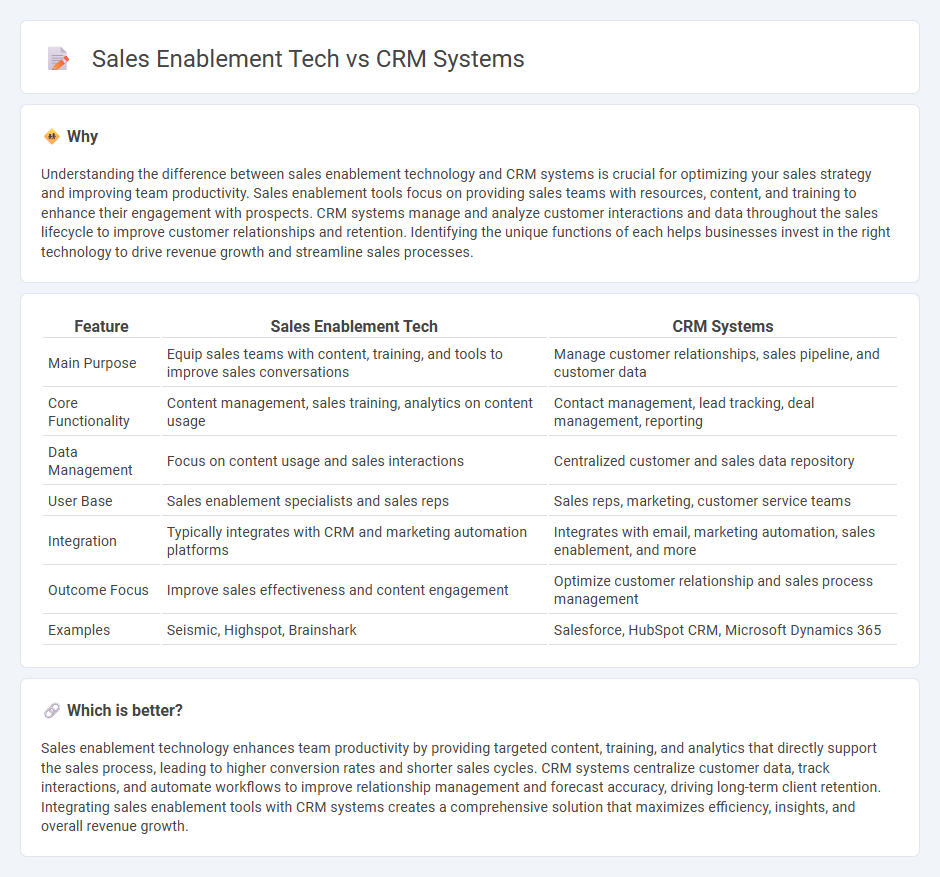
Sales enablement technology equips sales teams with tools such as content management, training resources, and analytics to improve buyer engagement and accelerate deal cycles. CRM systems primarily focus on managing customer relationships, tracking interactions, and organizing sales pipelines to enhance customer data visibility and workflow efficiency. Explore the distinct benefits of sales enablement tech versus CRM systems to optimize your sales strategy.
Why it is important
Understanding the difference between sales enablement technology and CRM systems is crucial for optimizing your sales strategy and improving team productivity. Sales enablement tools focus on providing sales teams with resources, content, and training to enhance their engagement with prospects. CRM systems manage and analyze customer interactions and data throughout the sales lifecycle to improve customer relationships and retention. Identifying the unique functions of each helps businesses invest in the right technology to drive revenue growth and streamline sales processes.
Comparison Table
| Feature | Sales Enablement Tech | CRM Systems |
|---|---|---|
| Main Purpose | Equip sales teams with content, training, and tools to improve sales conversations | Manage customer relationships, sales pipeline, and customer data |
| Core Functionality | Content management, sales training, analytics on content usage | Contact management, lead tracking, deal management, reporting |
| Data Management | Focus on content usage and sales interactions | Centralized customer and sales data repository |
| User Base | Sales enablement specialists and sales reps | Sales reps, marketing, customer service teams |
| Integration | Typically integrates with CRM and marketing automation platforms | Integrates with email, marketing automation, sales enablement, and more |
| Outcome Focus | Improve sales effectiveness and content engagement | Optimize customer relationship and sales process management |
| Examples | Seismic, Highspot, Brainshark | Salesforce, HubSpot CRM, Microsoft Dynamics 365 |
Which is better?
Sales enablement technology enhances team productivity by providing targeted content, training, and analytics that directly support the sales process, leading to higher conversion rates and shorter sales cycles. CRM systems centralize customer data, track interactions, and automate workflows to improve relationship management and forecast accuracy, driving long-term client retention. Integrating sales enablement tools with CRM systems creates a comprehensive solution that maximizes efficiency, insights, and overall revenue growth.
Connection
Sales enablement technology and CRM systems are interconnected tools that streamline the sales process by integrating customer data, content management, and communication tracking in one platform. CRM systems provide a centralized database of customer interactions and sales pipelines, while sales enablement tech delivers targeted content, training, and analytics to empower sales teams to engage prospects effectively. Together, they enhance sales productivity, improve customer relationships, and drive revenue growth through data-driven decision-making.
Key Terms
Customer Data Management (CRM systems)
CRM systems centralize customer data management, enabling businesses to collect, organize, and analyze detailed customer information such as contact details, purchase history, and interaction records. This centralized data repository supports personalized marketing efforts and improves customer relationship tracking, leading to higher retention rates and sales growth. Explore how integrating CRM systems can transform your customer data management strategy and boost business performance.
Content Management (Sales enablement tech)
Sales enablement technology excels in content management by providing centralized repositories that organize, customize, and distribute sales materials efficiently, enhancing sales team productivity and client engagement. Unlike CRM systems that primarily track customer interactions and manage relationships, sales enablement tools optimize content usage by delivering contextually relevant assets at every stage of the sales funnel. Explore how advanced content management capabilities in sales enablement technology can transform your sales strategy.
Workflow Automation (Both)
CRM systems streamline customer data management and automate sales workflows by integrating contact information, sales tracking, and communication tools to enhance efficiency. Sales enablement technology complements CRM by providing content management, training modules, and real-time analytics to empower sales teams during engagements. Discover how combining CRM workflow automation with sales enablement tech drives revenue growth and operational agility.
Source and External Links
What is a CRM System? Everything You Need to Know - This article provides a comprehensive overview of CRM systems, including types such as operational, analytical, and collaborative CRMs, and their key features for managing customer relationships.
12 Powerful CRMs and Use Cases for a Growing Business - This resource highlights examples of operational CRMs and their use cases, focusing on automation and process improvement for sales, marketing, and customer service.
Customer Relationship Management (CRM) - This Wikipedia page offers a detailed explanation of CRM as a strategic process, including its technological components and applications across various industries.
 dowidth.com
dowidth.com